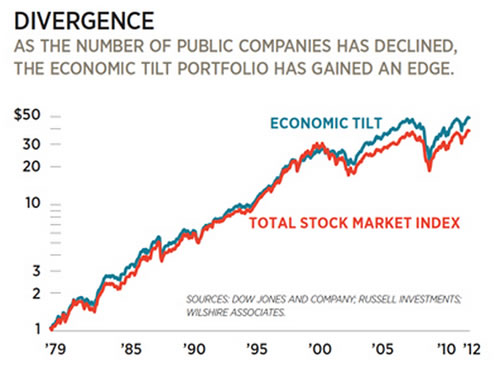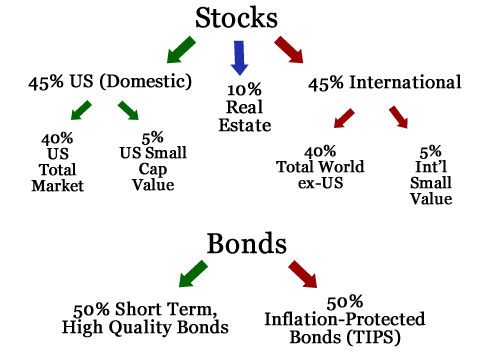In many investing books such as David Swensen’s Unconventional Success or Bill Schultheis’ The Coffeehouse Investor, you may see model portfolios that include an allocation to smaller companies and/or real estate investment trusts (REITs). Historically, adding these less-correlated asset classes have improved a portfolio’s overall return while reducing volatility. Author and portfolio manager Rick Ferri proposes another lens from which to view why such additions add value in his Forbes article called The Total Economy Portfolio.
Briefly, Ferri points out that the number of publicly traded companies has fallen by over 50% in the last 16 years, and those public companies together earn only about half of the U.S. economy’s profits. What is missing, and what should we do to replace them?
The two main areas of the economy that are underrepresented on the stock market are small businesses and commercial real estate. That means increasing small company and real estate exposure in your portfolio should help you track the economy better. […] My “Economic Tilt Portfolio” is allocated 65% to the Wilshire 5000, 25% to the Russell 2000 small-cap value index and 10% to the Dow Jones U.S. Select Real Estate Investment Trust index.
The chart from the article below compares the total return of the Total US Stock Market (Wilshire 5000) vs. the Economic Tilt Portfolio:

I found this interesting as the breakdown is similar to my own asset allocation. Instead of a 65%/25%/10% breakdown, you could view my target asset allocation as 73%/18%/9% when only focusing on the US Stocks + REITs:

I don’t know if I agree with this framework, but I do feel comfortable with the additions of small-cap value companies and REIT exposure in my portfolio. I view them as improving the overall market coverage and diversification of a plain Total US market fund, while also providing income in the form of dividends and rental payments.
 The Best Credit Card Bonus Offers – 2025
The Best Credit Card Bonus Offers – 2025 Big List of Free Stocks from Brokerage Apps
Big List of Free Stocks from Brokerage Apps Best Interest Rates on Cash - 2025
Best Interest Rates on Cash - 2025 Free Credit Scores x 3 + Free Credit Monitoring
Free Credit Scores x 3 + Free Credit Monitoring Best No Fee 0% APR Balance Transfer Offers
Best No Fee 0% APR Balance Transfer Offers Little-Known Cellular Data Plans That Can Save Big Money
Little-Known Cellular Data Plans That Can Save Big Money How To Haggle Your Cable or Direct TV Bill
How To Haggle Your Cable or Direct TV Bill Big List of Free Consumer Data Reports (Credit, Rent, Work)
Big List of Free Consumer Data Reports (Credit, Rent, Work)
Great post Jonathan. I totally agree on on the small-cap and REITs. My portfolio is quite similar to yours and tilts towards value stocks and has quite a bit of small cap stocks — both Small Cap Index and Small Cap Value Index fund. I also have devoted 10% to REITs. Recession of 2008 provided great opportunity to buy REITs. I hold only REITs in my Roth IRA. Holding REITs in Roth IRA also shields you from tax burden. Once again good info.
I used to hold REIT fund in a taxable account. Ugh, the tax was really confusing (unrecaptured gains, etc). I would pretty much only recommend REIT in non-taxable accounts.